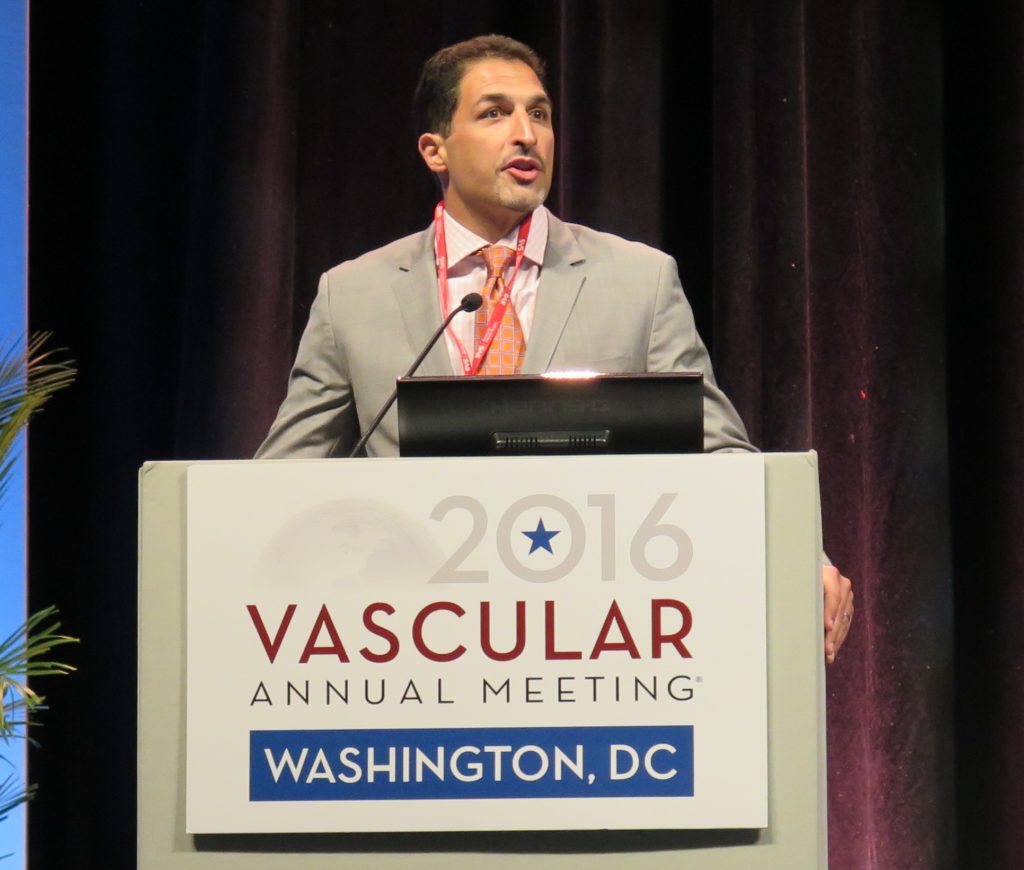
Initial results from the STABLE II study indicate that a covered stent graft with a bare metal stent is safe and effective in treating acute, complicated type B aortic dissection. The results were presented at the Vascular Annual Meeting (9–11 June, National Harbor, USA) by Joseph Lombardi, Cooper University Hospital, Camden, USA.
“Management of complicated type B aortic dissection has greatly improved with endovascular therapy over the last decade, with improved survival and improved long-term remodelling,” Lombardi told the Meeting audience. He continued, “However, dissection following thoracic endovascular aneurysm repair (TEVAR) still has some challenges. Endografts are largely designed for aneurysm treatment and there is significant failure in the abdominal aorta with growth rates of 35–40%. Management of visceral aortic expansion is the most challenging of all secondary interventions.”
The STABLE II study is investigating the use of a composite device design—a covered stent graft (Zenith TX2 endovascular graft, Cook Medical) with a bare metal stent (Zenith dissection endovascular stent, Cook Medical). STABLE II is a prospective, non-randomised, multicentre study involving 73 patients (66% male, mean age 61 years) enrolled between August 2012 and January 2015 at institutions in the USA and Japan. The primary safety endpoint for the trial is the rate of freedom from major adverse events at 30 days and the primary effectiveness endpoint is the rate of survival at 30 days. Lombardi’s presentation at the Vascular Annual Meeting reported study data as of January 2016, with available follow-up exams in 97% and 85% of patients eligible for follow-up at 30 days and 12 months, respectively.
Patients presented with branch vessel obstruction/compromise (73%, 53/73), aortic rupture (22%, 16/73), or both (5.5%, 4/73). A covered stent graft main body was used in all patients (median one graft, range 1–3; one stent graft used in 71%, 51/73). A bare dissection stent was used in 58 of 73 patients (80%). Lombardi explained that the main reasons for not using a bare dissection stent included in cases of limited dissection and an absence of false lumen flow.
Lombardi reported that five deaths (6.8%) occurred within 30 days (due to presenting aortic dissection, ischaemic bowel, multiple organ failure, stroke, and aortic rupture). Thirty-day major adverse events included one case of myocardial infarction, one bowel ischemia, five strokes, four cases of paraplegia/paraparesis, seven cases of chronic renal insufficiency/renal failure requiring dialysis, and 10 situations requiring prolonged ventilator support.
From day 31–365, nine deaths occurred (one of which was related to dissection repair) and a further three patients experienced major adverse events (two with chronic renal insufficiency/renal failure requiring dialysis, and one with both stroke and bowel ischaemia). Within 12 months, nine patients underwent secondary interventions; no patients required conversion to open surgery.
Mean true lumen diameter increased from 22.3mm to 33.8mm in the descending thoracic aorta and from 18.4mm to 25.8mm in the abdominal aorta from pre-procedure to 12 months. Concomitantly, the mean false lumen diameter decreased from 18.4mm to 8.6mm in the descending thoracic aorta and from 15.3mm to 12.3mm in the abdominal aorta. Growth (>5mm) of the maximum transaortic diameter was seen in 11% (5/45, thoracic) and 17% (7/41, abdominal) of patients at 12 months.
“I think the big thing here is reintervention. It is facile with the device, and you can get access to a target vessel with a narrow false lumen and then intervene to shut down re-entry flow,” Lombardi explained.
“These preliminary results from the STABLE II study appear favourable in terms of clinical and anatomical outcomes for the treatment of acute chronic type B aortic dissection,” concluded Lombardi.
Discussing which patients should not be offered this treatment, Lombardi said, “The majority of the investigators hesistated to put a dissection stent where the dissections were focal and exclusive only to the thoracic aorta. In addition to that, perhaps rupture situations do not require a dissection stent and that is one area where I probably would not put one in.”
In response to a question from the audience as to whether use of a bare metal stent should be considered standard of care following reperfusion, Lombardi said, “I think now we are starting to see that TEVAR does not prevent aneurysm formation, and we are seeing 30–40% growth in the abdominal aorta, specifically in the visceral component, which is very difficult to deal with afterwards. Having that dissection stent there really makes it a lot easier, as you can get access to the visceral vessels and you can exclude the false lumen much more easily. I do not think it is an end all be all, but I think it takes you out of the rough and puts you on the fairway for a better shot.”













